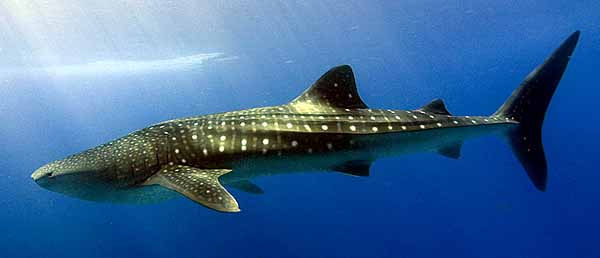Rhincodon typus
Smith, 1828
|
Familie: Rhincodontidae SynonymeRhiniodon typus (Smith, 1828)
Rhinodon typicus Müller & Henle, 1839 Lokale Bezeichnung |
Typen
Holotypus: MNHN 0000-9855 (ausgestopft, montiert).
Typusfundort: Table Bay, Südafrika, südöstlicher Atlantik.
Etymologie
Dient als typisch für die Gattung. (Übersetzt aus: The ETYFish Project)
Verbreitung
Zirkumglobal, alle tropischen und warmen gemäßigten Meere mit Ausnahme des Mittelmeeres.
IUCN Status

EX Extinct (ausgestorben)
EW Extinct in the Wild (in der Natur ausgestorben)
CR Critically Endangered (vom Aussterben bedroht)EN Endangered (stark gefährdet)
VU Vulnerable (gefährdet)
NT Near Threatened (potenziell gefährdet)
LC Least Concern (nicht gefährdet)
RE Regionally Extinct (regional oder national ausgestorben)DD Data Deficient (ungenügende Datengrundlage)
NE Not Evaluated (nicht beurteilt)
EN Endangered (stark gefährdet)
Grund für die Gefährdungseinstufung: Zu den Hauptbedrohungen der heutigen Zeit für Walhaie zählen Fischerei, Beifang in Netzen und Verletzungen durch Schiffsrammung. Andere Bedrohungen betreffen den Walhai auf lokaler oder regionaler Ebene. (Details)
Literatur
vor 1900
- Smith, A. 1828. Descriptions of new, or imperfectly known objects of the animal kingdom, found in the south of Africa. South African Commercial Advertiser, 3 (145): 2. Zitatseite [:2, !!]
- Smith, A. 1829. Contributions to the natural history of South Africa, & c. Zoological Journal, London, 4 (16) (art. 54): 433-444. Zitatseite [:443, als Rhiniodon typus]
- Müller, J.P. & Henle, F.G.J. 1838–41. Systematische Beschreibung der Plagiostomen. Veit und Comp., Berlin. i–xxii + 1–200, 60 pls. BHL Zitatseite [:77, als Rhinodon typicus]
- Smith, A. 1838-47. Pisces. In: Illustrations of the zoology of South Africa; consisting chiefly of figures and descriptions of the objects of natural history collected during an expedition into the interior of South Africa in 1834-36. 4: 77 unnummerierte Seiten u. Pls. 1-31. (BHL)Zitatseite [: ohne Seitenzahl, Pl. 26, als Rhinodon typicus]
- Gill, T.N. 1865. On a new generic type of sharks. Proceedings of the Academy of Natural Sciences of Philadelphia, 17: 177. (BHL) Zitatseite [:177, !! als Micristodus punctatus]
1900-1949
- Kishinouye, K. 1901. A rare shark, Rhinodon pentalineatus n. sp. Zoologischer Anzeiger, 24 (657/658): 694-695. (BHL) Zitatseite [:694, Figs. 1-2, !! als Rhinodon pentalineatus]
1950-1989
Robins, C. R. & R. N. Lea (1975): Proposed suppression of Rhiniodon Smith, 1828 (Pisces) in favour of Rhincodon Smith, 1829 as the generic name of the whale shark. Z.N. (S.) 2090. Bull. Zool. Nomencl. v. 32 (no. 3): 163-167.: 1975:163-167
- Compagno, L.J.V. 1984. FAO species catalogue. Vol. 4. Sharks of the World. An annotated and illustrated catalogue of shark species known to date. Part 1 - Hexanchiformes to Lamniformes. i-viii + 1-249. (PDF) / Part 2. Charcharhiniformes. No. 125, 4 (2): 251-655. Zitatseite : 1984:210f
- International Commission on Zoological Nomenclature 1984. Opinion 1278 The generic name Rhincodon A. Smith, 1829 (Pisces): conserved. Bulletin of Zoological Nomenclature, 41: 215-217. (PDF) Zitatseite
Wolfson, F. H. (1986): Occurrences of the whale shark, Rhincodon typus Smith. Pp. 208-226. In: Uyeno et al. (eds.) 1986 [ref. 6147]. Indo-Pac. Fish Biol.: 1986:208-226
TAYLOR,G.:Whale sharks of Ningaloo reef,W-Australia:a preliminary study.(West Aust Nat 18(1)1989): 1989:7-12
1990-1999
AQUATICA - der Blaue Planet, Aquatica Verlags GmbH, Salzburg, Österreich. Heft 1: 20.Sept.1996: 1996/1:4
2000-2009
VELTE,F.: Der größte Fisch der Welt ist eine bedrohte Art. (DATZ 53(9)2000:55): 2000/09:55
Wirtz, P. (2005): Neue Fische für Madeira und die Azoren. Das Aquar., 430,4: 48-53.: 2005/04:50*
Stewart, B.S. & Wilson, S.G. (2005): Threatened Fishes of the World: Rhincodon typus (Smith 1828) (Rhincodontidae). Environmental Biology of Fishes, 74 (2): 184-185.: 2005/02:184f
Blessin, H. (2006): Ein Walhai im Aquarium. DATZ 59 (2): 27.: 2006/02:27
Rowat, D., Meekan, M.G., Engelhardt, U., Pardigon, D. & Vely, M. (2007): Aggregations of juvenile whale sharks (Rhincodon typus) in the Gulf of Tadjoura, Djibouti. Environmental Biology of Fishes, 80 (4): 465-472.: 2007/04:465ff
Bradshaw, C.J.A. (2007): Swimming in the deep end of the gene pool: global population structure of an oceanic giant. Molecular Ecology (2007) 16, 5111-5114.: 2007:5111-14
Castro, A.L.F., Stewart, B.S., Wilson, S.G., Hueter, R.E., Meekan, M.G., Motta, P.J., Bowen, B.W. & Karl, S.A. (2007): Population genetic structure of Earth's largest fish, the whale shark (Rhincodon typus). Molecular Ecology, 16: 5183-5192.: 2007:5183-92
- Wirtz, P. 2008. Walhaie und andere Fische neu bei Madeira. Die Aquarien- und Terrarienzeitschrift (DATZ), 61 (11): 42-43. Zitatseite : 2008/11:42*
Brunnschweiler, J.M., Baensch, H., Pierce, S.J. & Sims, D.W. (2009): Deep-diving behaviour of a whale shark Rhincodon typus during long-distance movement in the western Indian Ocean. Journal of Fish Biology, 74 (3): 706-714.: 2009/03:706ff
2010-2019
- Boldrocchi, G. & Bettinetti, R. 2019. Whale shark foraging on baitfish off Djibouti. Marine Biodiversity, [1-4]. First Online: 17 January 2019. (doi) Zitatseite
2020-
- Miranda, J.A., Yates, N., Agustines, A., Enolva, N.P., Labaja, J., Legaspi, C., McCoy, E., Ponzo, A., Snow, S. & Araujo, G. 2020. Donsol: an important reproductive habitat for the world's largest fish Rhincodon typus? Journal of Fish Biology, First published: 08 November 2020. (doi) Zitatseite
- Green, S.M., Hearn, A. & Green, J.R. 2023. Species associated with whale sharks Rhincodon typus (Orectolobiformes, Rhincodontidae) in the Galapagos Archipelago. Biodiversity Data Journal, 11: e97864. (doi) Zitatseite
- Whitehead, D.A. & Gayford, J. 2023. First record of bottom-feeding behaviour in the whale shark (Rhincodon typus). Journal of Fish Biology, 103 (2): 448-452. (doi) Zitatseite
